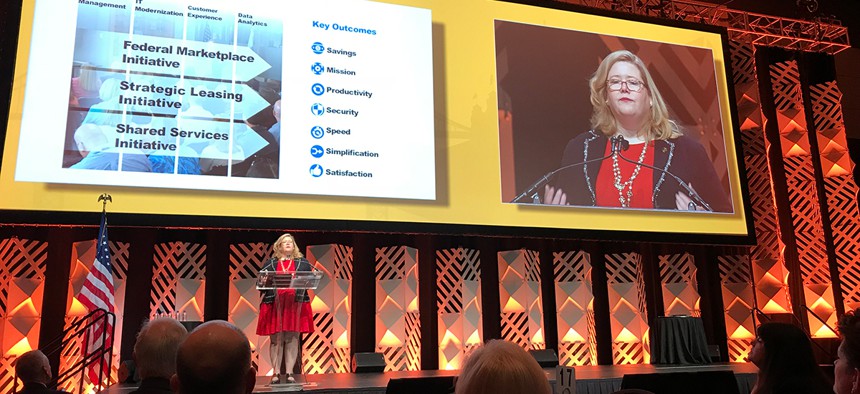sponsor content What's this?
GSA’s Murphy Talks Transformation, Automation and Modernization

Presented by
FedTech

The General Services Administration is undergoing major changes as the government works to upgrade its technology.
A little more than nine months before its 70th birthday, as the government works to modernize its technology, the General Services Administration is reimagining itself to deliver its mission in new and more efficient ways.
“If you look at what GSA is enabling now, it’s not goods, it’s not services, it’s solutions,” says GSA Administrator Emily Murphy, speaking at the Imagine Nation ELC 2018 conference in Philadelphia.
The agency has cut down the number of GSA schedules from 24, it’s improved its catalog and ordering tools, and it’s added unpriced services contracts.
“That drives competition for solutions,” she says. “We enable our agency customers to buy solutions, and we enable our industry partners to deliver solutions.”
Schedule modernization is key to this effort, she says: “If you’re trying to sell something or facilitate the sale of something and people can’t find it, that’s a problem.
GSA Turns to Data to Drive Efficiency
GSA is collecting data about what customers and vendors want and need and translating that into action toward modernized, streamlined systems that let people search easily for information, often with less paperwork along the way, she says.
With the advent of “X as a Service” business models, determining the best price to pay has become complicated, she adds; legislation changing the rules on how agencies pay for purchases might help.
“This is one of the challenges we have when we’re looking at the cloud — how do we make sure we’re getting the best value? A lot of the rules right now force us to buy as if we’re looking for the maximum amount we need rather than buying by the drink,” Murphy says.
The agency has also turned to data analysis as a way to save money. Through robotic process automation, the agency analyzed lease data on the 370 million square feet of workspace that it manages and saved about $900 million last year for its customers, Murphy says. There are plans to do it again.
“There’s one initiative that we’re hoping to launch this year that, in and of itself, will save 10,000 hours of work a week. That’s five years for any individual person,” she says. “That gives us the ability to reskill that person for high-value work.”
GSA Works to Keep Employees Informed of Cultural Changes
GSA is working with its employees to make sure they’re all on board with the ongoing cultural changes, which include incorporating the Office of Personnel Management’s HR Solutions office into GSA, expected to happen next year.
Murphy has sent emails to employees, held town halls, provided videos and created working groups of career employees — she even invites midlevel employees to have coffee with her. “There’s been a lot of communication,” she says. “They see a lot of the opportunities this is going to bring.
“We can’t will change into being. It’s something we have to inculcate into the agency.”
Read more articles and check out videos from FedTech’s coverage of Imagine Nation ELC 2018 here.
This content is made possible by FedTech. The editorial staff of Nextgov was not involved in its preparation.
NEXT STORY: How Agencies Are Spending TMF Money





